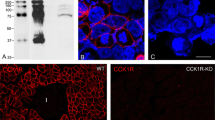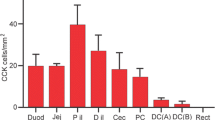Abstract
The CCK-A (cholecystokinin-A) receptor is selectively expressed by human pancreatic adenocarcinomas, suggesting a possible role in pancreatic tumorigenesis. In animals, pancreatic CCK receptor expression varies during ontogeny and neoplastic transformation. This study examined the temporal expression of CCK receptors in human fetal, postnatal, and adult pancreas to determine whether the appearance of CCK-A receptors in pancreatic adenocarcinomas reflected oncofetal antigen or pancreatic neoantigen expression. Messenger ribonucleic acid (mRNA) was isolated from six paraffin-embedded normal pancreatic autopsy specimens ranging in age from 17 weeks postfertilization through 26 days following full-term delivery, and samples of adult human tissues, including pancreas and pancreatic adenocarcinoma. Using reverse transcription-polymerase chain reactions, CCK-B receptor mRNA was expressed in all specimens of normal fetal and postnatal human pancreas, adult pancreas, and pancreatic adenocarcinomas. CCK-A receptor mRNA was selectively expressed only in pancreatic adenocarcinomas. These data suggest that selective CCK-A receptor expression in pancreatic adenocarcinomas reflects neoantigen expression in humans.
Similar content being viewed by others
REFERENCES
Wank SA, Pisegna JR, deWeerth A: Cholecystokinin receptor family-molecular cloning, structure, and functional expression in rat, guinea pig and human. Ann NY Acad Sci 713:49-66, 1994
Wank SA: Cholecystokinin receptors. Am J Physiol 269(32):G628-G646, 1995
Weinberg DS, Ruggeri B, Barber M, Biswas S, Miknyocki S, Waldman SA: Cholecystokinin A and B receptors are differentially expressed in normal pancreas and pancreatic adenocarcinoma. J Clin Invest 100(3):597-603, 1997
Mainz DL, Black O, Webster PD: Hormonal control of pancreatic growth. J Clin Invest 52:2300-2304, 1973
Povoski SP, Zhou W, Longnecker DS, Jensne RT, Mantey SA, Bell RH: Stimulation of in vivo pancreatic growth in the rat is mediated specifically by way of cholecystokinin A receptors. Gastroenterology 107:1135-1146, 1994
Herrington MK, Adrian TE: On the role of cholecystokinin in pancreatic cancer. Int J Pancreatol 17(2):121-138, 1995
Miller LJ: Does the human pancreas have a type A or a type B personality? Gastroenterology 111(6):1767-1770, 1996
Escribano MJ, Cordier J, Nap M, Ten Kate F, Burtin P: Differentiation antigens in fetal human pancreas. Reexpression in cancer. Int J Cancer 38:155-160, 1986
Mies C: Molecular biological analysis of paraffin-embedded tissues. Hum Pathol 25:555-560, 1994
Chomczynski P, Sacchi N: Single step method of RNA isolation by acid guanidinium thiocyanate phenol chloroform extraction. Anal Biochem 162:156-157, 1987
Puissant C, Houdebine LM: An improvement of the single step method of RNA extraction by acid guanidinium thiocyanate phenol chloroform extraction. BioTechniques 8:148-149, 1990
Beverley SM: Enzymatic amplification of RNA by PCR. In Current Protocols in Molecular Biology. FM Ausubel, R Brent, RE Kingston, et al (eds). New York, John Wiley & Sons, 1994, pp 15.4.1-15.4.6
Kramer M, Coen DM: Enzymatic amplification of DNA by PCR: Standard procedures and optimization. In Current Protocols in Molecular Biology. FM Ausubel, R Brent, RE Kingston, et al (eds). New York, John Wiley & Sons, 1994, pp 15.1.1-15.1.8
Walther W, Stein U, Eder C: RNA analysis using miniprep RNA in reverse transcription PCR. BioTechniques 17:674-675, 1994
Lee P, Lebenthal E: Prenatal and postnatal development of the human exocrine pancreas. In The Pancreas-Biology, Pathobiology and Disease, 2nd ed. V Go, E DiMagno, J Gardner, E Lebenthal, H Reber, G Scheele, (eds). New York, Raven Press, 1993, pp 57-74
Lebenthal E, Lee P: Development of functional response in human exocrine pancreas. Pediatrics 66:556-560, 1980
DuBois P, Paulin C, Chayvialle J: Identification of gastrinsecreting and cholecystokinin-secreting cells in the gastrointestinal tract of the human fetus and adult man. Cell Tissue Res 175:351-356, 1976
Werlin S: Ontogeny of secretory function and cholecystokinin binding capacity in immature rat pancreas. Life Sci 40:2237-2245, 1987
Leung Y, Lee P, Lebenthal E: Maturation of cholecystokinin receptors in pancreatic acini of rats. Am J Physiol 250:G594-G597, 1986
Hajiivanova C, Defresne M, Poirot P, Sozzari P, Vaysse N: Pharmacological and biochemical characterization of cholecystokinin/gastrin receptors in developing rat pancreas. Eur J Biochem 204:273-279, 1992
Le Meuth V, Philouze-Rome V, Le Huerou-Luron I, et al: Differential expression of the A-and B-subtypes of the cholecystokinin/gastrin receptors in the developing calf pancreas. Endocrinology 133:1182-1191, 1993
Zhou W, Povoski S, Bell RH: Overexpression of messenger RNA for the cholecystokinin-A receptor and novel expression of messenger RNA for gastrin (cholecystokinin-B) receptor in azaserine induced rat pancreatic carcinoma. Carcinogenesis 14:2189-2192, 1993
Potter V: Recent trends in cancer biochemistry: The importance of studies on fetal tissue. Can Cancer Conf 8:9, 1969
Githens S: Differentiation and Development of the Pancreas in Animals. In The Pancreas-Biology, Pathobiology and Disease, 2nd ed. V Go, E DiMagno, J Gardner, E Lebenthal, H Reber, G Scheele, (eds) New York, Raven Press, 1993, pp 21-56
Fujii Y, Albers G, Carre-Llopis A, Escribano M: The diagnostic value of the foetoacinar pancreatic protein in cancer of the pancreas; a comparative study with CA19/9. Br J Cancer 56:495-500, 1987
Werlin S, Stefaniak J: Effects of hydrocortisone and cholecystokinin-octapeptide on neonatal rat pancreas. J Pediatr Gastroenterol Nutr 1:591-595, 1982
Wisner J, Ozawa S, Xue B-G, Renner I: Chronic administration of a potent cholecystokinin receptor antagonist L-364,718 fails to inhibit pancreatic growth in preweanling rats. Pancreas 5:434-438, 1990
Chang A, Jamieson J: Stimulus-secretion coupling in the developing exocrine pancreas: secretory responsiveness to cholecystokinin. J Cell Biol 103:2353-2365, 1986
Smith JP, Framer ST, Solomon TE: CCK stimulates the growth of six human pancreatic cancer cell lines in serum free medium. Regul Pept 32:341-349, 1991
Hoosein NM, Keiner PA, Curry RC, Brattain MG: Evidence for autocrine growth stimulation of cultured colon tumor cells by a gastrin/cholecystokinin-like peptide. Exp Cell Res 186:15-21, 1990
Matsumori Y, Katakami N, Ito M, Taniguchi T, Iwata N, Takaishi T: Cholecystokinin-B/gastrin receptor: A novel molecular probe for human small cell lung cancer. Cancer Res 55:276-279, 1995
Author information
Authors and Affiliations
Rights and permissions
About this article
Cite this article
Weinberg, D.S., So, C., Ruggeri, B. et al. Human Cholecystokinin-A Receptor Is Not an Oncofetal Protein. Dig Dis Sci 45, 538–543 (2000). https://doi.org/10.1023/A:1005449308536
Issue Date:
DOI: https://doi.org/10.1023/A:1005449308536




